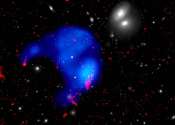Astronomers inspect interstellar medium of the galaxy SPT0346-52
Using the Atacama Large Millimeter/submillimeter Array (ALMA), an international team of astronomers observed an interstellar medium in a distant star-forming galaxy SPT0346-52. The collected data could be essential in improving ...









